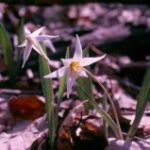| Common Name: |
Hound's Tongue |
| Other Names: |
Carolina Vanilla, Deer's Tongue, Deertongue, Vanilla Plant, Wild Vanilla |
| Botanical Name: |
Trilisa odoratissima syn. Liatris odoratissima |
| Genus: |
Trilisa |
| Family: |
Compositae |
| Native Location: |
Southeastern USA |
| Habitat: |
Woodland Garden; Sunny Edge; Dappled Shade; |
| Cultivation: |
Grows well in any moderately good light soil. Plants grow in very acid soils in the wild. |
| Propagation: |
Seed - sow in a greenhouse as soon as it is ripe in the autumn. When they are large enough to handle, prick the seedlings out into individual pots and grow them on in the greenhouse for at least their first winter. Plant them out into their permanent positions in late spring or early summer, after the last expected frosts. Division in spring.
|
| Harvest: |
Leaves are collected as needed and are used dried for flavoring. |
| Hardiness: |
It is hardy to zone 0. |
| Parts Used: |
Leaf |
| Medicinal Uses: |
The leaves are demulcent, diaphoretic, diuretic and tonic. They are a folk remedy for coughs, malaria and neuroses. The leaves are high in coumarins and have been experimentally effective in the treatment of high-protein oedema.
To treat malaria. |
| Typical Dose: |
There is no typical dose of deer's tongue. |
| Possible Side Effects: |
Deer's Tongue's side effects include allergic reactions in those sensitive to herbs from the Asteraceae (daisy) family, such as German Chamomile, Daisy, or Dandelion. |
| Drug Interaction: |
| Taking deer's tongue with these drugs may increase the risk of bleeding or bruising: |
| Abciximab, (ReoPro) |
Antithrombin III, (Thrombate III) |
Argatroban, (Argatroban) |
Aspirin, (Bufferin, Ecotrin) |
| Aspirin and Dipyridamole, (Aggrenox) |
Bivalirudin, (Angiomax) |
Clopidogrel, (Plavix) |
Dalteparin, (Fragmin) |
| Danaparoid, (Orgaran) |
Dipyridamole, (Novo-Dipiradol, Persantine) |
Enoxaparin, (Lovenox) |
Eptifibatide, (Integrillin) |
| Fondaparinux, (Arixtra) |
Heparin, (Hepalean, Hep-Lock) |
Indobufen, (Ibustrin) |
Lepirudin, (Refludan) |
| Ticlopidine, (Alti-Ticlopidine, Ticlid) |
Tinzaparin, (Innohep) |
Tirofiban, (Aggrastat) |
Warfarin, (Coumadin, Jantoven) |
|
| Supplement Interactions: |
Increased risk of bleeding when used with herbs and supplements that might affect platelet aggregation. |
| Culinary Uses: |
Condiment. The leaves are used as a flavouring, they have the scent of vanilla. Some caution is advised. |
| Economic Uses: |
Repellent. The dried leaves contain coumarin and have a scent like newly mown hay. They can be used as a condiment.
|
| Bibliography: |
F. Chittendon. RHS Dictionary of Plants plus Supplement. 1956 Oxford University Press 1951
Hedrick. U. P. Sturtevant's Edible Plants of the World. Dover Publications 1972 ISBN 0-486-20459-6
Triska. Dr. Hamlyn Encyclopaedia of Plants. Hamlyn 1975 ISBN 0-600-33545-3
Foster. S. & Duke. J. A. A Field Guide to Medicinal Plants. Eastern and Central N. America. Houghton Mifflin Co. 1990 ISBN 0395467225
Britton. N. L. Brown. A. An Illustrated Flora of the Northern United States and Canada Dover Publications. New York. 1970 ISBN 0-486-22642-5
The Complete Herb-Drug-Vitamin Interaction Guide by Geo. T. Grossberg,MD and Barry Fox,PhD Copyright©2007 Barry Fox,PhD Pp. 182-183
|

